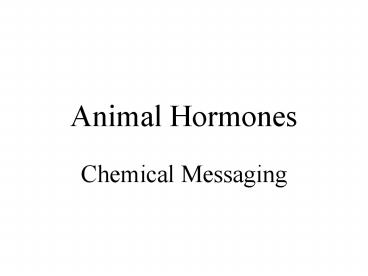Animal Hormones - PowerPoint PPT Presentation
1 / 56
Title:
Animal Hormones
Description:
five non-tropic hormones or groups. growth hormone. prolactin. melanocyte-stimulating hormone ... mediates the 'fight-or-flight' response. adrenal glands ... – PowerPoint PPT presentation
Number of Views:420
Avg rating:3.0/5.0
Title: Animal Hormones
1
Animal Hormones
- Chemical Messaging
2
Hormones
- component of homeostatic control
- slower signals (vs. nervous signals)
- secreted by endocrine cells
- diffuse to blood vessels
- delivered by circulatory system
3
hormone deliveryFigure 42.1
4
Hormones
- component of homeostatic control
- broadcast signals
- dispersed throughout the body
- received by target cells with receptors
- response is determined by target cells
- e.g. epinephrine (adrenaline) targets
- heart liver
- blood vessels adipose tissues
5
Hormones
- cellular mechanisms of control
- hormone release
- nervous system control
- feedback control
- receptor availability
- genetic control
- feedback control
6
multiple receptors and transduction pathways
7
Hormones
- cellular mechanisms of control
- signal transduction
- pathway - specificity
- cascade - amplification
- hormone half-life
8
Hormones
- component of homeostatic control
- controlled responses include
- developmental responses
- physiological responses
- behavioral responses
9
autocrine hormones bind source cellsFigure 42.1
10
Hormones
- not all hormones travel far
- autocrine hormones bind source cell
- paracrine hormones bind nearby cells
- histamine released by mast cells
- interleukin-1 released by macrophage cells
- neurotransmitters
11
neurotransmitters are paracrine signalsFigure
42.1
12
Hormones
- identical hormones are found in different animals
- roles may be different
- stimulus may differ
- target cells may differ
- responses may differ
- e.g. cAMP
13
Hormones
- endocrine cells may be single or organized into
an organ (gland) - different endocrine cells may be present in an
endocrine gland - in humans, nine endocrine glands make up the
endocrine system
14
glands of the human endocrine systemFigure
42.2
15
an invertebrate example
- insect development
- larval stages - instars
- separated by
- shedding of rigid exoskeleton - molt
16
an invertebrate example
- Rhodnius
- 5 molts
- molts are triggered by blood meals
17
Rhodniusheadless moltingFigure 42.3
18
transfer from one individual to anotherFigure
42.3
19
an invertebrate example
- Rhodnius
- two hormones trigger molting
- brain hormone
- produced in brain
- stored in corpora cardiaca
- released by blood meal stimulus
20
an invertebrate example
- Rhodnius
- two hormones trigger molting
- ecdysone
- produced in prothoracic gland
- released in response to brain hormone
- diffuses to target tissues
- stimulates molting
21
molting and development are not equivalent
- Rhodnius
- proper development is controlled by another
hormone - corpora allata produce juvenile hormone
- if corpora allata are intact, instars molt to
instars - 5th instar linked to 4th instar molts to 6th
instar rather than adult
22
brain hormone, ecdysone, juvenile hormone
interaction is common among insects -complete
metamorphosis Figure 42.4
23
human endocrine system
- pituitary gland - master gland
- attached to hypothalamus
- links nervous system with endocrine system
- produces secretes hormones
- or
- secretes brain hormones
- controls many endocrine glands
24
human endocrine system
- pituitary gland - master gland
- two-part gland
- posterior pituitary
- outgrowth of the hypothalamus
- stores secretes neurohormones
- antidiuretic hormone (ADH)
- oxytocin
25
posterior pituitaryFigure 42.5
26
human endocrine system
- pituitary gland - master gland
- two-part gland
- anterior pituitary
- outgrowth of mouth cavity
- produces and secretes several hormones
- responds to hypothalamic control
- neurohormones to portal vessels
- portal vessels to ant. pit.
- release or inhibit ant. pit. secretion
27
anterior pituitaryFigure 42.7
28
human endocrine system
- pituitary gland - master gland
- two-part gland
- anterior pituitary
- four tropic hormones control endocrine glands
- thyrotropin
- adrenocorticotropin
- luteinizing hormone
- follicle-stimulating hormone
29
human endocrine system
- pituitary gland - master gland
- two-part gland
- anterior pituitary
- five non-tropic hormones or groups
- growth hormone
- prolactin
- melanocyte-stimulating hormone
- endorphins enkephalins
30
global control of hormonal release
- hypothalamus receives information
- hypothalamus stimulates or inhibits pituitary
- pituitary secretion controls effectors directly
or indirectly - negative feedback loops convey internal
information to hypothalamus or pituitary
31
negative feedback control of hormone
productionFigure 42.8
32
control of thyroxine production
- thyroid gland produces thyroxine (T4 T3)
- thyroxine
- elevates cellular metabolic rate
- promotes use of carbohydrate over fat
- increases basal metabolic rate in response to
prolonged cold - promotes uptake of amino acids/protein synthesis
during development
33
control of thyroxine production
- failure of control can produce goiter
- hyperthyroidism
- autoimmune stimulation of thyrotropin receptor
- hypothyroidism
- e.g. iodine deficiency
- loss of feedback inhibition
34
thyroid parathyroid glands
35
control of blood calcium
- calcitonin
- produced by thyroid gland
- reduces level of circulating calcium
- reduces osteoclast activity
- stimulates osteoblast activity
36
control of blood calcium
- parathyroid hormone
- produced by parathyroid glands
- stimulated by low blood calcium
- stimulates osteoclasts
- increases calcium reabsorption by kidneys
- enhances dietary uptake of calcium
37
control of blood calcium
- antagonistic activities of pairs of hormones such
as calcitonin and parathyroid hormone are common
among homeostatic regulatory systems
38
antagonistic activities of calcitonin and
parathyroid hormone balance blood calciumFigure
42.9
39
control of blood glucose
- insulin
- produced by islet of Langerhans cells in the
pancreas - produced when blood glucose is high
- stimulates target cells to
- take up glucose
- synthesize glycogen
- synthesize fat
40
control of blood glucose
- glucagon
- produced in other islet cells
- produced when blood glucose is low
- stimulates liver to break down glycogen
41
control of blood glucose
- antagonistic activities of insulin and glucagon
maintain glucose at set point - failure of control may lead to diabetes
- when insulin or its receptors are absent, cells
use fat and proteins for fuel
42
control of blood glucose
- somatostatin overrides steady state control
- produced in pancreas
- response to rapid glucose/amino acid rise
- inhibits insulin and glucagon release
- reduces digestive activity of gut
- increases time of absorption/use of dietary
nutrients - also produced by hypothalamus to inhibit
thyrotropin growth hormone release
43
the adrenal glandsFigure 42.10
44
adrenal glands
- located on top of kidneys
- two parts
- adrenal medulla
- produces epinephrine norepinephrine
- derived from nervous tissue
- under nervous system control
- mediates the fight-or-flight response
45
adrenal glands
- located on top of kidneys
- two parts
- adrenal cortex
- produces several corticosteroid hormones
- under control of adrenocorticotropin
- slower to respond than adrenal medulla
46
corticosteroids come from cholesterolFigure
42.11
47
adrenal cortex
- corticosteroids are derived from cholesterol
- mineralocorticoids affect
- ionic balance of extracellular fluids
- aldosterone causes kidney to
- conserve Na
- excrete K
48
adrenal cortex
- corticosteroids are derived from cholesterol
- glucocorticoids affect
- blood glucose
- fat, protein, carbohydrate metabolism
- cortisol
- shifts non f-or-f cells to fat/protein catabolism
- blocks immune system function
- slow stress response
49
adrenal cortex
- corticosteroids are derived from cholesterol
- cortisol
- responds to adrenocoritcotropin (ACTH)
- ACTH-releasing hormone produced by hypothalamus
- negative feedback by cortisol reduces
ACTH-releasing hormone - ability to recover from stress can decrease with
age
50
adrenal cortex
- corticosteroids are derived from cholesterol
- sex steroids affect
- sexual development
- reproductive activities
51
sex steroids
- produced predominantly in gonads
- progesterone estrogens (estradiol)
- female sex steroids
- androgens (testosterone)
- male sex steroid
52
sex steroids
- mediate development of reproductive organs in
fetus - mediate sexual maturation development of
secondary sexual characteristics
53
sex steroids
- sex steroid control circuit
- in males, LH causes androgen production in testes
- in females, LH, FSH, cause female sex steroid
production in ovaries
54
sex steroids
- GnRH stimulates gonadotropin production
- luteinizing hormone
- follicle-stimulating hormone
- sex steroids limit GnRH production by negative
feedback - sensitivity of GnRH-producing cells to sex
steroids decreases to initiate puberty
55
Take Home
- hormone secretion is under multi-level control
- hypothalamus collects external information
- pituitary responds to hypothalamus
- pituitary controls many functions directly or
through other endocrine glands - many endocrine functions are controlled by
feedback mechanisms - many effectors are controlled by the antagonistic
activities of two or more hormones
56
Table 42.1































